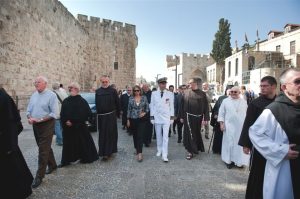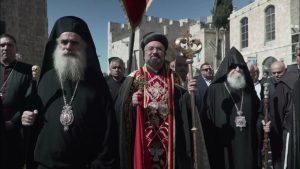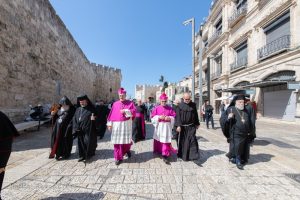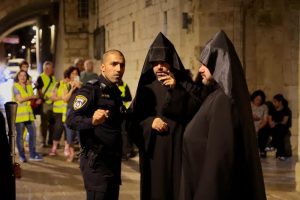Introduction
Processions in Jerusalem are a common sight, and in recent decades, they have been the subject of photographed media reports. These colorful spectacles are visually pleasing, but this public externalization of Christianity has its limitations. Under Muslim rule, Christians had to obtain permission to hold processions, and whether or not it was granted depended on the whims or benevolence of the ruler. However, since British and Jordanian rule and now under Israeli rule, Christianity in Jerusalem has been able to maintain its presence, and processions have taken place without restrictions. The presence of police for security and representatives from government ministries can be seen as non-verbal approval of the processions.
In recent years, however, some individuals have shown a lack of enthusiasm and would like to limit or eliminate this manifestation of Christianity in the public sphere. The battle over the definition of public space is now taking place between individual Jews and the historical Christian presence, while other Jews are actively involved in civil organizations to ensure that this presence remains undisturbed.
This article describes the processions that are held today and the inter-religious dynamics surrounding them over the last twenty years. I will contend that the Jaffa Gate area served as a showcase of Christian presence and rights, and therefore, it is a venue more susceptible to friction. The purpose of this short text is to provide a historical framing for the presence and significance of processions, both religious and otherwise, in the life of the city, and to contextualize the current events and vulnerability of this long-standing aspect of Jerusalem‘s urban matrix.
Christian Processions
Processions were and still are one of the most visible manifestations of the Christian world and its triumph. With the acceptance of Christianity as a permitted and later official religion, the community would take to the streets, carrying the cross, and proclaiming its existence and mission, using various means, such as liturgical and heraldic objects, vocal and instrumental music, special dress, and so forth. The importance of the procession can be seen in the Christian protocol for the Mass ceremony. In the Latin Christian tradition, the Mass begins with a procession of priests from the church gate to the altar area and ends with a procession in the reverse direction. In the Orthodox mass, there are two processions—one with the Book of the Gospel and the other with the Eucharist. These processions take place within the interior architectural space of the church, but the typical Orthodox church also has an external square (temenos) for outdoor processions. In general, Christian processions extend onto the city streets, such as the Palm Sunday procession, the Procession of the Cross, the Corpus Christi procession, and so forth.
Christian Processions in Jerusalem
Jerusalem was known in the Christian world as the physical setting in which the history of redemption was fulfilled in human form, in flesh and blood. Unlike other places, in Jerusalem, the story of Jesus was reenacted through a physical journey from station to station, according to the traditional identification of the sites where the various events occurred. Processions were conducted according to the perceived course of Jesus’s movements, for example, from the Mount of Olives to the Church of the Holy Sepulchre, from Mount Zion to Gethsemane, from Gethsemane to Mount Zion, along the Via Dolorosa, and so forth. These processions were permitted after the Roman Empire converted to Christianity in the fourth century. Multiple accounts are found in the literature describing processions throughout the holidays, testifying to their popularity among locals and pilgrims alike. In due course, places around the world sought to recreate the geographical features of the city of Jesus, thus leading to the emergence of parallel processions. Paradoxically, unlike the holy land, these processions continued uninterrupted over the years around the world, far from Jerusalem.
Following the golden age of the Byzantine and Crusader eras, and under the Muslim conquerors, the rights of Christians were curtailed, including in the field of processions. Attempts by Christians to hold processions that had been routine during the golden age met with refusal or limited approvals. And so, for hundreds of years, the unique processions of Jerusalem did not take place, or were limited in scope. A compensation for the pilgrims was the invention of a procession inside the Church of the Holy Sepulchre, as an imitation of what was supposed to take place outside the city. This “small Via Dolorosa” inside the Church of the Holy Sepulchre still exists to this day.
As the power of the Ottoman regime declined, especially in the second half of the nineteenth century, the local churches began to enjoy a greater degree of freedom. Alongside the rising power and demands of the global powers, more processions were gradually permitted. Further research will be required to describe the processes by which the authorities permitted the renewal of the processions. However, their revival in an era when the status quo of the holy places for Christianity was solidified (Paris 1856, Berlin 1878) gave rise to a tradition of Christian processions in Jerusalem that survives to this day.
A Typology of Processions
Processions show various patterns of repetition. Those grounded in the annual cycle occur once a year (e.g., Palm Sunday procession), while others follow a weekly cycle (e.g., the Procession of the Cross on Fridays along the Via Dolorosa). Christian pilgrims to the city add additional processions that are not bound to a particular festival or date but follow the same routes and patterns.
The processions can be divided into several categories: liturgical and ritual, when the altar or holy site is the point of reference, and official, pragmatic or ceremonial processions which feature the passage of an officiating clergy, entourage, or dignitaries. There are also popular processions which form another category, consisting of Christian laypeople and not necessarily accompanied by priests; these processions are referred to in Arabic as zaffa.
In Jerusalem, most liturgical and ritual processions take place in areas of the city where the presence of Jews is minimal: in the Christian Quarter, the Muslim Quarter, while some continue to and from Gethsemane and the Mount of Olives. Some processions are confined to the Christian quarter only, such as the May Catholic procession for Mary that departs from the Franciscan Custodia, as well as the popular Holy Fire procession (zaffa) that departs from the Greek Orthodox Patriarchate.
Most of the processions feature attendants who wear special suits and red Tarbush hats, carrying staffs with which they strike the floor in a regular rhythm, thereby acoustically greeting the procession. These attendants are known as qawas and serve as a reminder of the Ottoman period when they manifested the government’s consent to the holding of a procession. Nowadays there is no need for a qawas as an expression of the sovereign’s consent, but the denominations maintain this custom, thereby emphasizing their seniority and historical rights.
Jaffa Gate
Christian pilgrims arriving in Jerusalem from Jaffa historically entered through Jaffa Gate, in contrast to Muslim pilgrims arriving from the north and entering through Damascus Gate. Starting from the nineteenth century, the entire area near the gate was built over and occupied by significant Christian institutions, such as the Anglican bishopric, the Latin Patriarchate, the American consulate, the Austrian post office, hostels for pilgrims, and so forth. During this period, Jaffa Gate acquired an additional formal function during the inauguration of senior Christians through a reception and festive procession. These official and ceremonial processions welcomed a new appointee to his office in the city of Jerusalem or presented a dignitary worthy of a similar honor.
One of the earliest such events, if not the first, was the festive entry of the first Protestant bishop of Jerusalem, Michael Solomon Alexander, in 1842 as the representative of the Lutheran and Anglican churches. In 1848, a Latin patriarch, Giuseppe Valerga, arrived in the city for the first time since the Crusader era. The vivid display of an official ceremonial procession is preserved in the Franciscan archives: On the 17th of January, halfway between Ein Karem and the Holy City, the guardian and the Discretorium came to pay homage to the Patriarch, accompanied by the French and Sardinian consuls in full uniform and by “all the Europeans who lived in Jerusalem.” The patriarch was then accompanied in procession to Jaffa Gate, “where some kawas and a detachment of janissaries awaited him; sent by the governor of the city together with his personal gift: a pompous well adorned white horse.” Having climbed on its back, the Patriarch made his entrance into the city, greeted by “several cannon shots” and by an armed picket of soldiers. They found “a crowd of Latin and Oriental Catholics and an immense population waiting for him of Turks, of heretics and even of Jews.”

(Jaffa Gate: Official festive entry of the new French general consul in Jerusalem)
An official ceremonial procession of a non-clerical dignitary took place in 1887, when Vittorio Emmanuele, son of King Umberto of Italy and heir to the throne, was received by the Franciscan Friars and the Latin Patriarch at Jaffa Gate and had a solemn procession to the Holy Sepulchre. The magnificence of such processions, especially under Muslim rule, was a manifestation of the Christian presence and Christian rights in the holy city, with the area of Jaffa Gate becoming their focus.
After 1967, the Jewish presence around Jaffa Gate intensified. A museum and police headquarters were established in the “Tower of David” complex, which previously housed the Ottoman, British, and Jordanian police stations and a detention center (the “Kishle”). Next to Jaffa Gate, an information center of the Ministry of Tourism was set up. A little further inside, shops and hotels managed by Arabs are located in ecclesiastical property. In recent years, these properties have become the subject of bitter legal disputes after some were purchased by Jewish associations. Jaffa Gate is the most important entry gate for Jewish tourists and visitors, and it is the only gate for vehicular entry. In every sense, Jaffa Gate serves as a symbol of the Old City of Jerusalem for both Jews and Christians.
Today, official ceremonial welcoming processions depart periodically from Jaffa Gate whenever a head of church arrives from outside the region to be instated. This includes the archbishops of the Coptic, Syrian, and Ethiopian denominations; Latin patriarchs; the custos (head of the Franciscan Custodia of the Holy Land); Vatican apostolic delegates; and cardinals visiting the Holy Land. French consuls are also honored with a procession from Jaffa Gate to the Church of the Holy Sepulchre, due to their historical role as protectors of Catholics in the Holy Land.

(Jaffa Gate: Official festive entry of the new archbishop of the Syriac Orthodox Church in the
Holy Land)

(Jaffa Gate: Official festive entry of a new ambassador from the Vatican)
Processions as a Focus of Friction
Since 1967, Jerusalem has been under Jewish sovereignty, and as such Israel has approved and accompanied Christian processions. During his long period of office, Mayor Teddy Kolek regularly attended and accompanied Christian processions and ceremonies. In the 2000s, Commissioner Niso Shaham attended the processions as a sign of respect for the heads of the churches, rather than for policing purposes. In recent years, the government presence has been minimal, and is usually limited to an official from the Ministry of the Interior who serves as the liaison with the Christian denominations. Nevertheless, the police are obliged to be present to block vehicle traffic and ensure smooth passage along the procession route.
With the increasing number of Jews visiting the Old City, reaching hundreds of thousands on holidays such as Passover, Sukkot, Shavuot, Tisha B‘Av, and Jerusalem Day, and with the rise in Jewish religious extremism, instances of aggression against the Christian presence in Jerusalem have multiplied. In June 2023, a hotline and data center for documenting harassment against Christians (RFDC) was established. Within six months, about ninety cases of harassment were recorded, including spitting, derogatory name-calling, graffiti, vandalism, and disruption of processions. In the first half of 2024, 48 such cases were recorded.
Most cases of harassment occur on the Street of the Armenian Patriarchate, Mount Zion, the Jaffa Gate area, and the Via Dolorosa route. With the exception of the Via Dolorosa, the other streets are regularly used by Jews walking toward the Western Wall and David’s Tomb and also serve as routes for the processions. From the Armenian Patriarchate alone, processions depart every two weeks, and sometimes weekly, for a functional purpose: to serve in the holy shrines. The priests of the Armenian community and seminarians, dressed in their habits and sometimes carrying a cross, usually march on their way to serving in the Church of the Holy Sepulchre. The processions are coordinated with the police and only begin after police officers arrive and close the street to vehicular traffic. The processions usually pass peacefully but occasionally encounter anti-Christian harassment. In all cases, the attackers are Haredi, nationalist-Haredi, or national-religious Jews, mostly men but not exclusively. Most of the attacks involve spitting, insults, and the physical disruption of the procession.
In general, most Israeli Jews, including the attackers, are not aware of the tradition of the processions and the ancient Christian presence in the Old City. Those who are antagonized view Jerusalem as a Jewish city, and they see Jaffa Gate as representing Jewish Jerusalem. The Jaffa Gate area is regularly adorned with Hebrew greetings for the Jewish holidays and other municipal activities, but there is no mention of any Christian feast, whether it be Easter or Christmas. Some Jewish inhabitants or visitors to the city find this incompatible with a procession that manifests a Christian presence. Some are enraged by the sight of a cross and others by the groups of robe-wearing clerics.

(Awaiting the procession: an Armenian clergyman and a police officer assigned to the event, with
Jewish volunteers (in yellow vests) in the background, accompanying the procession to
document any cases of harassment against the participants).
Civil Activity to Protect the Christian Processions in the Old City
Eight years ago, an organization called Window to Mount Zion was established on Mount Zion through the Jerusalem Intercultural Center. The organization seeks to foster neighborly relations between the followers of the different religions on Mount Zion and in the Old City. Among its various activities, Window to Mount Zion operates a group of volunteers who accompany the Christian processions, including the processions of all denominations to Mount Zion, and in particular, the Armenian processions to the Church of the Holy Sepulchre. In coordination with the Armenians, the volunteers are asked to assemble at the entrance to the Patriarchate, accompany the procession, and photograph the events. The procession moves along the Street of the Armenian Patriarchate toward the Jaffa Gate area, then continues down through the market, turning onto the Street of the Christians, and finally reaching the Church of the Holy Sepulchre. After the ceremonies in the church, the volunteers return to accompany the procession back along the same route to the Armenian Patriarchate. Harassment mainly occurs along the Street of the Armenian Patriarchate, in the Jaffa Gate area, and in the market. In some cases, the volunteers succeed in photographing the attacker, while in others, they approach individuals who seem likely to disrupt the event and manage to diffuse potential conflicts through conversation or distraction. Reporting cases of harassment to the Religious Freedom Data Center is a crucial part of this accompanying work. Reports are entered into a database, and documented cases are submitted as complaints to the police by the Hotline.
The accompaniers, who all wear yellow vests, have become a recognized fixture during the processions on Mount Zion, and particularly during the Armenian processions. Anyone who observes a procession in the Old City will notice several “actors”: Christian clerics dressed in their robes, the qawas, the police, and the yellow-vested volunteers as representatives of civil society. Naturally, the clerics identify and admire those Israelis who come to protect them. Over time, the merchants of the Old City have learned about this organization, and even the Israel Police recognizes it as a group that seeks to help without causing disruption and without claiming powers that are not theirs. In some cases, the police brief the accompaniers, reminding them that their function is to calm the situation and not to inflame the aggression of the attackers. The attackers, for their part, usually do not understand the meaning of the yellow-vested accompaniers, at least up to now.
Conclusion
Jaffa Gate is considered the showcase of the Old City, both due to its location and its role as a main entrance to the Old City. Both the Jewish and Christian populations identify it as their natural entry point to the city and as their legitimate space. Despite the physical manifestation and activities of Jews in and around the gate, Christians also have a visible presence, especially with the official ceremonial processions. These Christian processions serve as a physical confirmation of the churches’ existence and as being an integral part of the religious fabric of Jerusalem. In addition to paying respect to senior figures who participate in the processions (both clerical and non-clerical), the specific festivals, and religious symbols, the processions also send a non-verbal message to the entire community—governmental and non-governmental entities, Muslims and Jews—reaffirming the presence of Christians and their historical rights in the city. Some Jews perceive this affirmation of Christian spatial sharing and belonging as scandalous and a threat to the Jewish nature of the holy city. The increase in harassment toward Christians, especially procession participants, is indicative of this mindset.
Over the past eight years, civil initiatives have emerged alongside the churches, demonstrating a consistent commitment from a different segment of the Jewish public. These initiatives aim to escort, assist, and protect Christians in the public sphere in response to the growing Jewish resentment toward them in the Jaffa Gate area, as well as along other routes. In opposition to those Jewish individuals who have a different perspective on Christian rights and their physical manifestation and who claim Jewish spatial supremacy, these initiatives highlight the ongoing struggle to safeguard religious pluralism in Jerusalem.






